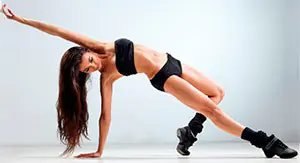The purpose of our article today is to take a deep dive into the question: Women's recreational gymnastics, what is it? And what do they eat it with, as they say? Let's consider the main directions of women's training, and also invite all representatives of the fair sex to the discussion - write your feedback in your comments to this article...
Women's recreational gymnastics classes include a variety of exercises:
- a) without subject,
- b) with a skipping rope,
- c) hoop
- d) ball
- e) ribbon, scarf.
Its main task is the comprehensive development of the body, its restoration after fatigue from various physical and mental stress, as well as the preservation of health, femininity, and a positive emotional state. The task of women's physical exercises is to teach the fair sex to adapt to the stresses of a professional and everyday nature, rationally use their strength, move economically, quickly respond to changes in external conditions and distribute their attention in accordance with them, accurately perform all labor and household motor actions. To solve this problem, with the help of women's gymnastics, coordination of movements, flexibility, strength and mobility of nervous processes are improved. The entire spectrum of physical influences on the body of those involved is involved: both dynamic and isometric static loads, for example, the very fashionable exercise “Plank” today, which gives simply amazing results despite its simplicity and uncomplicatedness. In this case, statics and isometrics are mainly included in the stages: warm-up and cool-down, and dynamics - in the main part of the training session. Such a complex, comprehensive effect on the entire body is the optimal cure for all diseases for many years.
Women's recreational gymnastics classes are conducted under the guidance of a teacher, coach or instructor at least three times a week for an average of 60 to 90 minutes and are supplemented with other sports. The classes use moderate loads, select individual elements and holistic dynamic dance exercises that best suit the characteristics of the female body and have a beneficial effect on the emotional state. When performing them, women with little training do not experience a subjective feeling of heaviness and fatigue. The dance nature of the exercises contributes to the beauty and expressiveness of movements.
When selecting exercises for a lesson, it is necessary to take into account their content, dosage and sequence, and the possibility of performing them to music. Acquiring and maintaining correct posture remains paramount throughout the entire learning and training process. Involved:
- I) exercises for the neck muscles,
- II) arms and shoulder girdle,
- III) for the muscles of the trunk,
- IV) pelvic girdle and legs,
- V) relaxation exercises.
When selecting exercises, it is necessary to achieve their variety. Such a comprehensive physical impact will effectively contribute to improving movements and strengthening the body of those involved…
Post Views: 71


